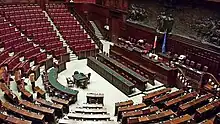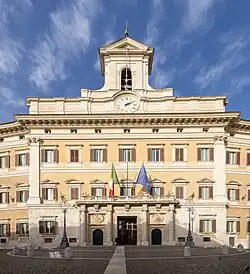Chamber of Deputies Camera dei Deputati | |
|---|---|
| 19th legislature (list) | |
 | |
| Type | |
| Type | of the Italian Parliament |
| Leadership | |
Vice Presidents | |
| Structure | |
| Seats | 400 |
 | |
Political groups | Government (238)
Opposition (162)
|
| Elections | |
| Mixed-member majoritarian representation: 147 FPTP seats, 253 PR seats with 3% electoral threshold (D'Hondt method) | |
Last election | 25 September 2022 |
Next election | no later than 2027 |
| Meeting place | |
 | |
| Palazzo Montecitorio, Rome | |
| Website | |
| en camera | |
| Rules | |
| Rules of Procedure of the Chamber of Deputies (English) | |
The Chamber of Deputies (Italian: Camera dei deputati) is the lower house of the bicameral Italian Parliament (the other being the Senate of the Republic). The two houses together form a perfect bicameral system, meaning they perform identical functions, but do so separately. The Chamber of Deputies has 400 seats, of which 392 will be elected from Italian constituencies, and 8 from Italian citizens living abroad. Deputies are styled The Honourable (Italian: Onorevole)[1] and meet at Palazzo Montecitorio.
Location
The seat of the Chamber of Deputies is the Palazzo Montecitorio, where it has met since 1871, shortly after the capital of the Kingdom of Italy was moved to Rome at the successful conclusion of the Italian unification Risorgimento movement.
Previously, the seat of the Chamber of Deputies of the Kingdom of Italy had been briefly at the Palazzo Carignano in Turin (1861–1865) and the Palazzo Vecchio in Florence (1865–1871). Under the Fascist regime of Benito Mussolini, the Chamber of Deputies was abolished and replaced by the figurehead Chamber of Fasces and Corporations from 1939 to 1943 (during World War II).
Normal operation
The Chamber is composed of all members meeting in session at the Montecitorio. The assembly also has the right to attend meetings of the Government and its ministers. If required, the Government is obligated to attend the session. Conversely, the Government has the right to be heard every time it requires.
The term of office of the House (as well as the Senate) is five years, but can be extended in two cases:
- The "prorogatio", as provided by art. 61.2 of the Constitution, states that deputies whose terms have expired shall continue to exercise their functions until the first meeting of the new Chamber.
- An extension of the term, provided for by art. 60.2, can be enacted only in case of war.
Electoral system
The electoral system is a mixed-member majoritarian with 37% of seats allocated using first-past-the-post voting (FPTP) and 63% using proportional representation, allocated with the largest remainder method, with one round of voting.
The 400 deputies are elected in:
- 147 in single-member constituencies, by plurality;
- 245 in multi-member constituencies, by national proportional representation;
- 8 in multi-member abroad constituencies, by constituency proportional representation.
For Italian residents, each house members are elected by single ballots, including the constituency candidate and his supporting party lists. In each single-member constituency the deputy/senator is elected on a plurality basis, while the seats in multi-member constituencies will be allocated nationally. In order to be calculated in single-member constituency results, parties need to obtain at least 1% of the national vote. In order to receive seats in multi-member constituencies, parties need to obtain at least 3% of the national vote. Elects from multi-member constituencies will come from closed lists.
The single voting paper, containing both first-past-the-post candidates and the party lists, shows the names of the candidates to single-member constituencies and, in close conjunction with them, the symbols of the linked lists for the proportional part, each one with a list of the relative candidates.
The voter can cast his vote in three different ways:
- Drawing a sign on the symbol of a list: in this case the vote extends to the candidate in the single-member constituency which is supported by that list.
- Drawing a sign on the name of the candidate of the single-member constituency and another one on the symbol of one list that supports them: the result is the same as that described above; it is not allowed, under penalty of annulment, the panachage, so the voter can not vote simultaneously for a candidate in the FPTP constituency and for a list which is not linked to them.
- Drawing a sign only on the name of the candidate for the FPTP constituency, without indicating any list: in this case, the vote is valid for the candidate in the single-member constituency and also automatically extended to the list that supports them; if that candidate is however connected to several lists, the vote is divided proportionally between them, based on the votes that each one has obtained in that constituency.
Article 61 of the Italian Constitution maintains that elections for the Chamber of Deputies must take place within 70 days of the dissolution of the house, and that representatives must convene within 20 days of those elections.
President
The President of the Chamber of Deputies (Presidente della Camera dei Deputati) performs the role of speaker of the house and is elected during the first session after the election. During this time the prerogatives of speaker are assumed by the vice president of Chamber of Deputies[2] of the previous legislature who was elected first. If two were elected simultaneously, the oldest deputy serves as president of Chamber of Deputies.
The President of Chamber of Deputies has also the role of President during the Parliament joint sessions, when the upper and lower houses have to vote together.
Lorenzo Fontana is the current president of the Chamber of Deputies.
| Name | Period | Legislature | |
|---|---|---|---|
| Giovanni Gronchi (DC) | 8 May 1948 – 29 April 1955 | I, II | |
| Giovanni Leone (DC) | 10 May 1955 – 21 June 1963 | II, III, IV | |
| Brunetto Bucciarelli-Ducci (DC) | 26 June 1963 – 4 June 1968 | IV | |
| Sandro Pertini (PSI) | 5 June 1968 – 4 July 1976 | V, VI | |
| Pietro Ingrao (PCI) | 5 July 1976 – 19 June 1979 | VII | |
| Nilde Iotti (PCI) | 20 June 1979 – 22 April 1992 | VIII, IX, X | |
| Oscar Luigi Scalfaro (DC) | 24 April 1992 – 25 May 1992 | XI | |
| Giorgio Napolitano (PDS) | 3 June 1992 – 14 April 1994 | ||
| Irene Pivetti (LN) | 16 April 1994 – 8 May 1996 | XII | |
| Luciano Violante (PDS) | 10 May 1996 – 29 May 2001 | XIII | |
| Pier Ferdinando Casini (CCD) | 31 May 2001 – 27 April 2006 | XIV | |
| Fausto Bertinotti (PRC) | 29 April 2006 – 28 April 2008 | XV | |
| Gianfranco Fini (PdL) | 30 April 2008 – 14 March 2013 | XVI | |
| Laura Boldrini (SEL) | 16 March 2013 – 22 March 2018 | XVII | |
| Roberto Fico (M5S) | 24 March 2018 – 12 October 2022 | XVIII | |
| Lorenzo Fontana (Lega) | since 14 October 2022 | XIX | |
Membership
The Chamber has 400 members. They were most recently elected at the 2022 general election.
Reform proposals
In 2019, the Italian parliament passed a constitutional law that reduces the number of the deputies from 630 to 400. The law was approved on 21 and 22 September 2020 by a referendum.[3]
Legislature XIX of Italy was the first one in which the number of Deputies was equal to 400.
Historical composition
1861–1924
| ||||||||||||||||||||||||||||
| 1861 |
| |||||||||||||||||||||||||||
| 1865 |
| |||||||||||||||||||||||||||
| 1867 |
| |||||||||||||||||||||||||||
| 1870 |
| |||||||||||||||||||||||||||
| 1874 |
| |||||||||||||||||||||||||||
| 1876 |
| |||||||||||||||||||||||||||
| 1880 |
| |||||||||||||||||||||||||||
| 1882 |
| |||||||||||||||||||||||||||
| 1886 |
| |||||||||||||||||||||||||||
| 1890 |
| |||||||||||||||||||||||||||
| 1892 |
| |||||||||||||||||||||||||||
| 1895 |
| |||||||||||||||||||||||||||
| 1897 |
| |||||||||||||||||||||||||||
| 1900 |
| |||||||||||||||||||||||||||
| 1904 |
| |||||||||||||||||||||||||||
| 1904 |
| |||||||||||||||||||||||||||
| 1909 |
| |||||||||||||||||||||||||||
| 1913 |
| |||||||||||||||||||||||||||
| 1919 |
| |||||||||||||||||||||||||||
| 1921 |
| |||||||||||||||||||||||||||
| 1924 |
| |||||||||||||||||||||||||||
Since 1945
| |||||||||||||||||||||||
| 1946 |
| ||||||||||||||||||||||
| 1948 |
| ||||||||||||||||||||||
| 1953 |
| ||||||||||||||||||||||
| 1958 |
| ||||||||||||||||||||||
| 1963 |
| ||||||||||||||||||||||
| 1968 |
| ||||||||||||||||||||||
| 1972 |
| ||||||||||||||||||||||
| 1976 |
| ||||||||||||||||||||||
| 1979 |
| ||||||||||||||||||||||
| 1983 |
| ||||||||||||||||||||||
| 1987 |
| ||||||||||||||||||||||
| |||||||||||||||||
| 1992 |
| ||||||||||||||||
| ||||||||||||||||||||||||
| 1994 |
| |||||||||||||||||||||||
| 1996 |
| |||||||||||||||||||||||
| 2001 |
| |||||||||||||||||||||||
| 2006 |
| |||||||||||||||||||||||
| ||||||||||||||||||||
| 2008 |
| |||||||||||||||||||
| 2013 |
| |||||||||||||||||||
| 2018 |
| |||||||||||||||||||
| 2022 |
| |||||||||||||||||||
Predecessors
- Chamber of Deputies (Kingdom of Sardinia) — 4 March 1848 to 17 March 1861
- Chamber of Deputies (Kingdom of Italy) — 17 March 1861 to 23 March 1939
- Chamber of Fasces and Corporations — 23 March 1939 to 2 August 1943
- National Council (Italy) — 25 September 1945 to 2 June 1946
- Constituent Assembly of Italy — 2 June 1946 to 31 January 1948
See also
Notes
References
- ↑ "onorevole [o-no-ré-vo-le] agg., s." Corriere della Sera. Dizionario di Italiano (in Italian). Retrieved 15 June 2020.
- ↑ There are four vice presidents who lead the debate when there is not the President of the chamber.
- ↑ "Il 20 e 21 settembre ci sarà il referendum sul taglio del numero dei parlamentari" (in Italian). Il Post. 15 July 2020. Retrieved 20 July 2022.
External links
 Obelisk of Montecitorio. In the background is the Italian Chamber of Deputies.
Obelisk of Montecitorio. In the background is the Italian Chamber of Deputies. Back side of Palazzo Montecitorio, designed by architect Ernesto Basile
Back side of Palazzo Montecitorio, designed by architect Ernesto Basile Front side of Palazzo Montecitorio.
Front side of Palazzo Montecitorio. Another photo of the main entrance of Montecitorio with the Montecitorio column.
Another photo of the main entrance of Montecitorio with the Montecitorio column.
